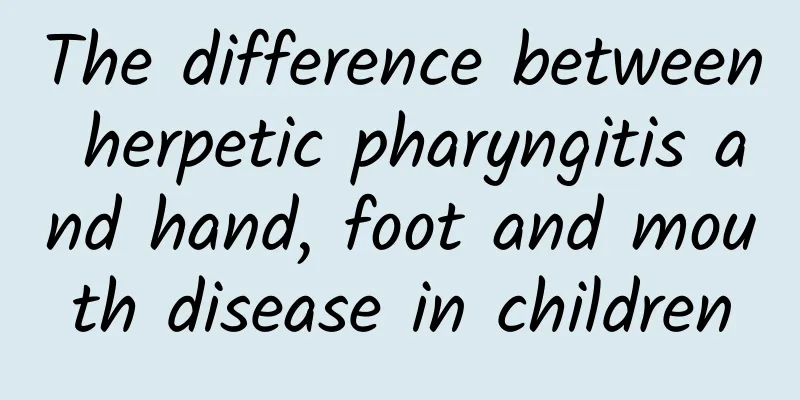The difference between herpetic pharyngitis and hand, foot and mouth disease in children

|
Herpetic pharyngitis and hand, foot and mouth disease are two common childhood diseases caused by viruses. The main difference between them lies in the symptoms and the location of the lesions. Parents can make a preliminary judgment by observing the symptoms of the children, but timely medical treatment is required for diagnosis. The following is a comparison and suggestions on symptom differences, causes and nursing methods. 1Differences in symptoms Herpangina is mainly manifested by lesions in the throat, with symptoms such as high fever, sore throat, and difficulty swallowing, accompanied by the formation of gray-white blisters or ulcers in the throat. The typical symptoms of hand, foot and mouth disease are small blisters or ulcers on the hands, feet, mouth, etc., which may be accompanied by low fever or mild sore throat. The fever of herpangina is usually more obvious than that of hand, foot and mouth disease, and the child will show persistent high fever or even extreme discomfort. 2 Analysis of etiology and lesion site The main cause of both diseases is enterovirus infection, such as Coxsackie virus group A, but herpetic pharyngitis mainly affects the throat, while hand, foot and mouth disease affects multiple parts of the body, such as the hands, feet, mouth and even buttocks. The virus is transmitted in similar ways, mainly through droplet transmission, close contact or contaminated food and toys, especially in summer and autumn. 3. Care and treatment methods Herpetic pharyngitis: ① It is recommended that children drink more warm water to relieve dehydration caused by high fever; ② If the fever is higher than 38.5℃, you can take antipyretics such as ibuprofen or acetaminophen as prescribed by your doctor; ③When the pain is obvious, you can use a local sore throat relief spray under the doctor's advice. Hand, Foot and Mouth Disease: ① When the local rash is itchy, you can apply calamine lotion; ② If obvious oral ulcers occur, rinse your mouth with saline or apply appropriate local analgesics; ③ Increase nutritional intake such as rice soup or warm liquid food, but avoid overly hot or high-fiber food that may irritate the affected area. 4 Precautions Because the two diseases are highly contagious, parents need to pay special attention to their children's hygiene habits: ① Educate children to wash their hands before and after meals, and avoid using unclean tableware and toys; ② Avoid taking your child to crowded places during the peak period of the disease; ③If a child in the family has been diagnosed, he/she should be isolated as much as possible to avoid cross infection, and toys, clothes, etc. should be cleaned and disinfected in time. If parents find that their children's symptoms are getting worse, with persistent high fever, or severe oral or skin ulcers, they should seek medical attention as soon as possible to avoid complications caused by the disease. These two diseases are mostly self-limiting, and physical exercise and maintaining a light diet can help enhance children's immunity and reduce the risk of illness. |
>>: Causes of hand, foot and mouth disease in adults
Recommend
Where is the best hospital for acute laryngitis in children?
Acute laryngitis in children is relatively rare i...
How to treat mumps in children and get better faster
Treatment of mumps in children should be a combin...
What can children eat to grow taller? Eating more of these 5 foods can help increase children's height
If you want to promote your child's growth, y...
How to prevent diarrhea in children? What are the symptoms of diarrhea in children?
Summer and autumn are generally the peak seasons ...
What are the main self-treatment methods for Kawasaki disease?
What are the main self-treatment methods for Kawa...
What are the symptoms of diarrhea and dehydration in children?
Children who suffer from dehydration due to diarr...
Can children with cold cough eat mango? Dietary treatment for children's cold cough
Children with cold cough can also eat some mangoe...
What medicines are used for pneumonia in children
Children are more susceptible to pneumonia due to...
What are the folk remedies for treating patent ductus arteriosus?
What are the folk remedies for treating patent du...
What is the cause of Hirschsprung's disease in children?
Hirschsprung's disease in children is mainly ...
Treating ADHD in Children with Medication
Children with ADHD can effectively improve their ...
Best treatment for eczema in a 4-year-old child
There are many factors that cause pediatric eczem...
What should I do if my baby has a cough, runny nose, or diarrhea? How should I use medicine if my baby has a cough, runny nose, or diarrhea?
Babies have very low resistance, so coughing, run...
How to treat hernia in children? Doctors point out the treatment and care methods of hernia in children
Hernia in children mainly occurs in the inguinal ...
Can breast milk diarrhea be treated without surgery?
Can breast milk diarrhea be treated without surge...









